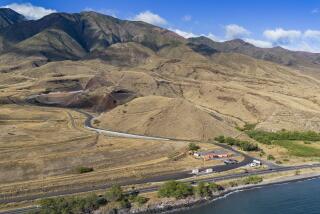Hawaiians reconnect to their past by planting taro
Given the gooey, sticky consistency of poi, it’s perhaps no surprise that tourists who try it at one of Hawaii’s luaus describe it as tasting like wallpaper paste.
Hawaiians say if it doesn’t taste sweet, it’s probably not freshly made. And, they ask, have those critics ever tasted wallpaper paste?
Taro, the native plant whose roots are mashed to make poi, has been a staple in Hawaiian households for centuries. Nowadays, proponents are citing its health benefits, boosting its popularity. But demand is outpacing supply, caused partly by development of what once were taro patches.
“A lot of our wetlands and lowlands that were perfect for agricultural production are now in housing,” said biologist Kanekoa Kukea-Shultz.
Kukea-Shultz is spearheading efforts on Oahu to reclaim the land for taro, and volunteers — locals and tourists — can help.
About 15 miles northeast of Waikiki, which was once a large taro patch, Kukea-Shultz manages 400 acres of wetland for Kakoo Oiwi, a nonprofit environmental group. Slowly, taro is being reintroduced with the help of volunteers who not only are helping preserve the land but also a piece of the culture.
On a recent Saturday morning, Brandon Lima and Brenda Asuncion, from neighboring Oahu communities, joined the effort. They arrived at Kakoo Oiwi’s land just north of Kaneohe on windward Oahu ready to work: They wore old clothes and flip-flops because they had been warned they would get dirty.
Soon, they were among about three dozen volunteers who were up to their knees in muck in a restored taro patch. Their task was to weed out invasive plants such as California grass and mangrove so the taro could thrive in the muddy water.
Just two acres are producing taro, but more is being planted. The paddies — loi in Hawaiian — do more than provide ideal growing conditions. They also trap runoff from the nearby Koolau mountains, preventing the nutrient-rich topsoil from washing into Kaneohe Bay. Such drainage promotes the unwanted growth of coral-choking algae.
Just a few miles away, on the other side of Kaneohe, Rick Barboza blends a for-profit nursery with a nonprofit botanical garden. At both, the mission is the same: to encourage Hawaiians to grow taro and other indigenous plants.
Barboza called his business a “taro bank” from which farmers can purchase kalo, Hawaiian for the plant.
“We try to promote Hawaiian culture and Hawaiian ecology,” he said.
Visitors are invited to wander through the Papahana Kuaola gardens to learn about dozens of native plants.
One day each month, people come here for what Barboza calls “community give-back” cultural experiences.
On a spring Saturday against a backdrop of lush mountains, Duffy Chang used an electric saw to turn rocks of various colors, shapes and sizes into poi pounders, the tools used to mash taro roots.
Micha Brunn from nearby Wahiawa brought her 14-year-old son, Miliana, to Papahana Kuaola to experience the ancient ritual. Participants search for suitable stones, then craft them into utensils. Micha was hopeful her son’s utensil would someday be a family heirloom.
“We’re here today,” she said, “because a lot of the tradition that’s involved in making poi with the kalo has been lost.
“Each family should have a rock to pound their kalo. It [the rock] actually calls to you. ... It will say, ‘Pick me, pick me.’ ”
Hawaiians hope that the renewed emphasis will make islanders pick taro as the starch of choice.
“We all eat a lot of rice,” Kukea-Shultz said. “Rice is a carbohydrate, but not a very healthy carbohydrate. Taro is … a healthy, complex carbohydrate. People that are diabetic or overweight, when they eat taro, they’ll start to lose weight and be much healthier.”
Even folks who shun poi can enjoy the health benefits of taro. The roots can be steamed or cooked as a vegetable. The meat for a common Hawaiian dish, laulau, is baked in taro leaves. With a taste sometimes compared to that of collard greens, taro leaves can be part of a healthful diet because they’re rich in calcium.
If you go: Taro restoration on Oahu, Hawaii
Kakoo Oiwi (kakoooiwi.org) holds community work days from 8:30 a.m.-noon on the second Saturday of each month. The site is along Kamehameha Highway just north of Kaneohe. Visit the website and click on “Get Involved” to view a map, get more information and register. Email questions to info@kakoooiwi.org.
Papahana Kuaola, 46 Haiku Road, Kaneohe; (808) 447-7694, papahanakuaola.com. Welcomes volunteers from 9 a.m.-noon on the third and fourth Saturdays of each month to help with restoration. Every fourth Saturday, after the work, lunch and free cultural workshops are offered. There’s no need to sign up in advance.
More to Read
Sign up for The Wild
We’ll help you find the best places to hike, bike and run, as well as the perfect silent spots for meditation and yoga.
You may occasionally receive promotional content from the Los Angeles Times.






